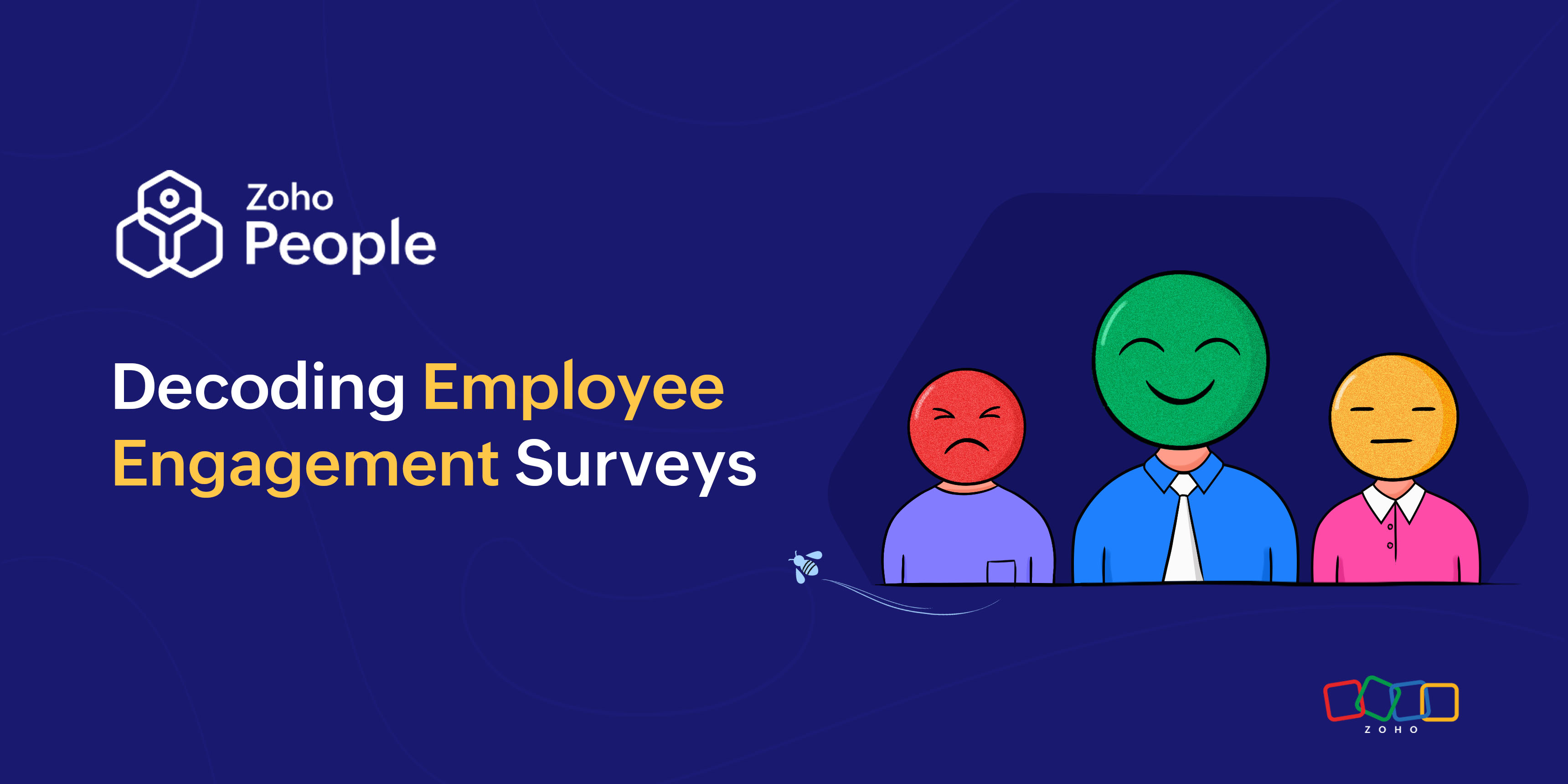- HOME
- More
- Employee Engagement
- Decoding employee engagement surveys
Decoding employee engagement surveys
- Last Updated : October 17, 2023
- 971 Views
- 5 Min Read

Employee engagement is a major workplace aspect that'll never go out of trend at any point in time. It's incredibly critical to a company's success as it decides how dedicated your employees are to your organization and how happy and satisfied they are with their current roles and responsibilities. This means that engaged employees put in more effort to achieve your organizational goals and keep your customers happy.
One of the best ways to ensure that your employees stay engaged is by running employee engagement surveys. But what are employee engagement surveys? How do they help your organization? How can you conduct one for your employees? Read on to get all your questions about employee engagement surveys answered.
What are employee engagement surveys?
Employee engagement surveys ask a certain set of questions to determine the engagement, motivation, and satisfaction levels of your workforce. They can help you understand how your employees feel about working for your organization and identify issues important to them.
How can employee engagement surveys benefit your organization?
When done right, employee engagement surveys can bring many benefits to your organization. Here are a few:
1. Provide valuable insights to drive change
By targeting the essential workplace aspects, employee engagement surveys can offer valuable insights into what employees wish to have at your organization. For instance, an employee engagement survey about learning and development opportunities at your organization can offer insights into how employees can progress at your organization, what they expect in terms of development if they require mentoring opportunities, and a lot more. Focusing on these aspects will help you bring better strategies that cater to employee needs and expectations.
2. Uncover common employee issues
When you regularly run employee engagement surveys, you can identify issues your employees are facing even before they start affecting other aspects of employee engagement. For instance, when you have a holistic engagement survey focusing on every facet of your organization, you can have a clear idea of which of your strategies are performing poorly, moderately, and exceptionally. This way, you can have more of what's performing well and improve strategies that aren't.
3. Make employees feel important
By running employee engagement surveys, you provide a space for your employees to voice their feedback, suggestions, and grievances without hesitation. This makes them feel valued. This also shows your interest in making your workplace a better place to work, which will only improve your employees' commitment to your organization.
4. Build an employee-first culture
Employee engagement surveys help you find more avenues to bring changes that prioritize your employees' needs and provide them an exceptional working experience. As a result, you'll be able to build an employee-centric culture that views employees as customers, while embracing each one of their unique perspectives.
How can you develop employee engagement surveys for your organization?
Here's how you can develop employee engagement surveys for your employees in a way that gathers actionable insights for your organization:
1. Set clear goals
Before you start to design your employee engagement survey, have a clear idea about what you wish to understand, analyze, and improve. Sometimes, you may simply want to check the pulse of your employees. Other times, you may want to understand which aspects of your strategies—for instance, a training strategy—are working well and which aren't. Or you may want to get a holistic picture of how your employee management strategies are working. By setting clear goals at the start of the survey, you'll be able to ask the right questions and get the best insights out of your surveys.
2. Ask the right questions
Based on the survey goals that you set, determine what kind of questions will help you gather those insights. For instance, if you're looking to understand employee engagement levels, questions that target work fulfillment, recognition, development opportunities, flexibility, and their decision to stay with your organization long-term can really help. Similarly, if you're trying to gauge employee happiness levels, questions that target individual vs. organizational goal alignment, teamwork, collaboration, manager support, feedback exchanges, and work-life balance can help you get the best results. Be sure to have a set of open-ended questions and keep the survey anonymous to get a lot of unfiltered and honest insights from your employees.
3. Select a survey tool
Adopt a survey tool that lets you build surveys and seamlessly circulate them to employees. With this survey tool, you should be able to include different types of questions that let your employees select from multiple answer choices, offer their comments, rate their experience, and a lot more. The survey tool should also help you define to which employees the survey should apply since not all surveys can be sent to all employees at all times. The survey tool should also help you notify employees regularly about the survey so that they can complete the survey on time.
4. Run analysis on the results
Once employees complete the survey, you must take steps to analyze it and take steps to address their grievances. Categorize the data based on designation, departments, location, etc., or whichever categorization works for you. This will help you uncover key trends and patterns from the survey data. Similarly, if you have descriptive answers from your employees, you can also run a sentiment analysis on the data using AI and machine learning to analyze if their tone is positive, negative, or neutral. Be sure to clearly get an idea about what the data is trying to tell you. Discuss the results with your C-level leaders and make decisions based on your employees' interests.
Running successful employee engagement surveys
Running employee engagement surveys can truly help you understand how exactly your employees perceive your organization, its management style, and what you can improve and change. We hope this blog gave you a clear idea about the basics of running employee engagement surveys!
Zoho People comes with a very comprehensive Employee Engagement module that lets organizations run short surveys with the help of the eNPS technique and more elaborate surveys with the help of annual engagement surveys. It even analyzes the survey results and presents them in a more digestible form. Learn more about Zoho People's Employee Engagement module.
 Tarika
TarikaContent Specialist at Zoho People


